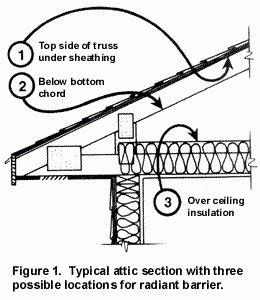
In residential homes, there are well-documented benefits to applying Radiant Barrier insulation into the attic envelope. These benefits are backed up by quite a bit of research by independent government funded labs including the prestigious Oak Ridge National Laboratory and The Florida Solar Energy Center in Cape Canaveral, Florida.
Traditional insulations like fiberglass and foam insulation have purely conductive properties. These conductive insulations are given R-Values determined by ASTM testing. The R-Value formulas describe insulation’s conductive resistance, but ignore radiant heat transfer.
Studies performed by the Florida Solar Project demonstrate that one thin layer of Radiant Barrier can be more effective blocking heat transfer in a building’s attic envelope than 6″ of fiberglass batting.
During the summer months, Polyshield Radiant Barrier is 97% efficient at blocking radiant heat transfer. When you apply a Polyshield Radiant Barrier over fiberglass batting you are essentially protecting your insulation from absorbing the radiant heat and re-emitting that heat back into your attic and living spaces. With reflective Radiant Barrier insulation, you will experience much more comfort in your home while saving on energy costs.
During the winter months the heat transfer reverses. Heat rises in your living space and conducts through the ceiling drywall, heating up your fiberglass batting. The heat in your insulation radiates into the bottom of your roof decking, heating your roof. This process can cause ice damming, which is a well-known and serious problem in the northern regions of the US. Applying Polyshield Radiant Barrier in your attic envelope will reflect that radiant heat back towards the fiberglass insulation on the roof flooring, saving heating costs and reducing ice-damming.
972 836 4829
